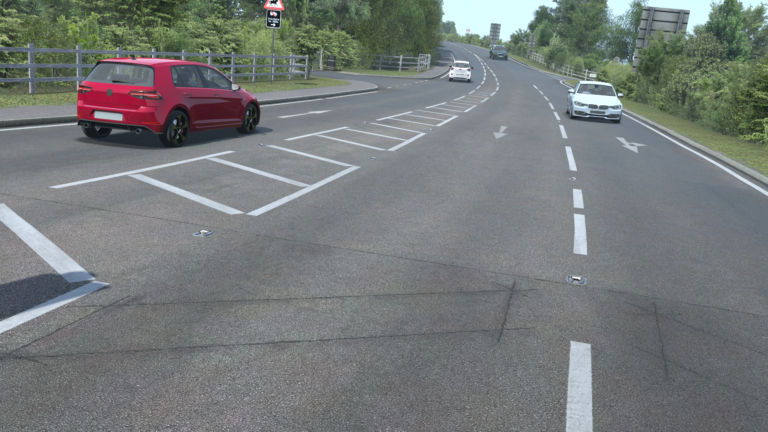Simulation software specialist rFpro has developed a highly detailed digital model of a rural road network near the village of Harbury in Warwickshire in the UK. The model offers a multi-functional simulation solution for vehicle development, ranging from vehicle dynamics and automated driving to powertrain and headlight tuning.
The digital twin spans 17.5km and includes more than 230 buildings, 190 selectable parking locations, 660 drain covers and over 2,000 roadside objects, such as lampposts, road signs and traffic lights. This creates a highly immersive experience for both human drivers and vehicle sensor systems.
The Harbury model has been created using survey-grade lidar data, ensuring a road surface accuracy of 1mm in height, making the model suitable for vehicle dynamics tuning. The virtual route contains typical British B-roads, replicating undulating corners and uneven surfaces. It also includes features such as speed bumps, reflective road studs (commonly known as cat’s eyes), drain covers, potholes and bridge expansion gaps. These elements ensure that engineers can assess a vehicle’s ride comfort, steering response and chassis behavior in a highly accurate and repeatable environment.
In addition to vehicle dynamics development, the model supports ADAS and autonomous vehicle testing with a variety of junctions, roudabouts (traffic circles) and challenging road layouts. The model is delivered with an OpenDrive network, allowing traffic scenarios and edge case tests to be set up inside this rich virtual environment. The Harbury model has been built with integrated ground truth data, which is essential for ADAS system validation testing.
Through rFpro’s fully integrated simulation solution, AV Elevate, the Harbury model can be used to generate highly accurate synthetic training data for machine learning algorithms. Users can randomize or specifically control pedestrians, traffic and parked vehicles, adjusting their type, color, and even how dirty vehicles are, to create varied test scenarios. The rFpro software also enables full control over environmental conditions, including time of day, weather and street lighting.
“Subjecting machine learning algorithms to variety is critical to avoid overfitting the perception model,” said Josh Wreford, AV Elevate product manager at rFpro. “For example, if you only subject a perception model to pedestrians in regular clothing, it will be confused when it comes across a worker in a high-visibility jacket. But this is also true for more granular details such as road markings and signs. We need to include the irregularities and nuances of the real world; that’s why our digital models are perfectly imperfect.”
For example, although the length, width and spacing of road markings are dictated by regulations, in reality, they vary in size, fade and don’t always meet exact specifications. As a result, the 2,900 road markings in the model, totaling more than 44km of paint lines, have been individually created to accurately replicate the real world.
The Harbury road route model is the latest addition to rFpro’s growing library of more than 190 digital models, which include public road routes, proving grounds and race circuits. The software has already been adopted by a major UK vehicle manufacturer.
In related news, Helm.ai, which provides AI software for ADAS, autonomous driving and robotics automation, recently introduced Helm.ai Driver, a real-time deep neural network (DNN) transformer based path prediction system for highway and urban Level 2 to Level 4 autonomous driving. Click here to read the full story.


